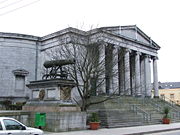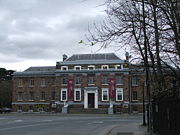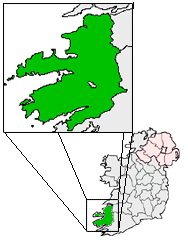Tralee
| Tralee Trá Lí |
||
| Vis Unita Fortior "United Strength is Stronger" |
||
|---|---|---|
| Location | ||
|
||
|
WGS-84 (GPS) Coordinates:
|
||
| Irish grid reference Q828141 |
||
| Statistics | ||
| Province: | Munster | |
| County: | County Kerry | |
| Elevation: | 37 m | |
|
Population (2006) |
20,288 2,456 |
|
| Website: www.tralee.ie | ||
Tralee (Irish: Trá Lí (or Tráigh Lí)) is the county town of County Kerry, in the southwest corner of Ireland. The name Tralee comes from the Irish 'Trá Lí', or 'Trá Laoi', which means 'strand of the Lee' (river), although some believe it comes from the Irish 'Trá Liath' meaning 'grey strand'. The town is situated on the northern side of the neck of the Dingle Peninsula. Tralee is the largest town in Kerry. The town's population including suburbs was 22,744 in the 2006 census.
Contents |
History



Situated at the confluence of some small rivers and adjacent to marshy ground at the head of Tralee Bay, Tralee is located at the base of a very ancient roadway that heads south over the Slieve Mish Mountains. On this old track is located a large boulder sometimes called Scotia's Grave, reputedly the burial place of an Egyptian Pharaoh's daughter. The Norman town was founded in the 13th century by Anglo-Normans and was a stronghold of the Earls of Desmond. A medieval castle and Dominican order Friary were located in the town. The mediaeval town was burnt in 1580 in retribution for the Desmond Rebellions against Elizabeth I. Tralee was granted to Edward Denny by Elizabeth I in 1587 and recognised by royal charter in 1613.
Sir Edward Denny, 4th Baronet was a notable landlord in his day: especially during the time of the Great Famine when instead of increasing his rents as so many landlords did at that time he maintained rents to suit his tenants. He was a notable Plymouth Brother.
A monument commemorating the 1798 rebellion – a statue of a Pikeman by Albert Power – stands in Denny Street.
The modern layout of Tralee was created in the 19th century. Denny Street, a wide Georgian street was completed in 1826 on the site of the old castle.
Tralee courthouse was designed by Sir Richard Morrison and built in 1835. It has a monument of two cannons commemorating those Kerrymen who died in the Crimean War (1854–56) and the Indian Rebellion (1857).
The Ashe Memorial Hall sits at one end of Denny Street, dedicated to the memory of Thomas Ashe - an Irish Volunteers officer in the Easter Rising of 1916. The building is built of local sandstone and houses the Kerry County Museum and a reconstruction of early Tralee.
Tralee saw much violence during the Irish War of Independence and Irish Civil War in 1919–1923. In November 1920, the Black and Tans besieged Tralee in revenge for the IRA abduction and killing of two Royal Irish Constabulary (RIC) men. The Tans closed all the businesses in the town and did not let any food in for a week. In addition they burned several houses and all businesses connected with Irish Republican Army (IRA) activists. In the course of the week, they shot dead three local people. The incident caused major international outcry when reported by the press, who wrote that near famine conditions were prevailing in Tralee by the end of the week.
In August 1922, during the Irish Civil War, Irish Free State troops landed at nearby Fenit and then took Tralee from its Anti-Treaty garrison. Nine pro-Treaty and three anti-Treaty soldiers were killed in fighting in the town before the anti-Treaty forces withdrew. However the republicans continued a guerrilla campaign in the surrounding area. In March 1923 an infamous atrocity was carried out by Free State troops near Tralee when nine anti-treaty IRA prisoners were taken from the prison in Tralee and blown up with a land mine at nearby Ballyseedy.
Tourism
Tralee is a major tourism destination and has seen some €55 million of tourism investment over the past several years. The town has developed a range of quality all weather visitor attractions. Tralee is also famous for the Rose of Tralee International Festival which is held annually in August.
Places of interest
- Kerry County Museum – incorporating the theme park 'Kerry: The Kingdom' and an exhibit which depicts life in medieval Geraldine Tralee.
- Siamsa Tíre – Ireland's National Folk Theatre, offering traditional music and plays in Irish.
- Blennerville Windmill located about 2 km outside the town, Ireland's largest still functioning windmill.
- Tralee Aquadome – A large indoor water leisure facility with a mini-golf course, located near Fels point, just off the Dan Spring road, at the Western exit from the town. The Slieve Mish Mountains range acts as a pretty backdrop to the site.
- Tralee-Dingle Railway – Departures also take place from the Aquadome site for trips on the restored part of the old Tralee to Dingle Railway. Local enthusiasts have brought back an original Hunslet steam engine from the USA to relive the days when the Tralee to Dingle line carried goods and passengers along the famous narrow-gauge picturesque route before it was finally closed in 1953. Visitors can take a short train ride in carriages imported from Spain pulled by the puffing Hunslet a few kilometres out to the Tralee Bay village of Blennerville. Here the restored Blennerville Windmill and Museum house a fascinating look into Tralee's historical past as a gateway to the new world in the 19th century. Nearby the Windmill stands the yard where the Jeanie Johnston wooden sailing ship replica was completed in 2002. The new Jeanie Johnston ship is now based in Dublin city docklands.
Archaeological sites
- Casement's Fort – an ancient Ring Fort where Roger Casement was hiding when arrested.
- Sheela na Gig – now located in the Christian Round Tower at Rattoo, a few km north of Tralee.
- Monument to Saint Brendan the Navigator at Fenit – with reproductions of ancient Irish structures
- Cathair Cun Rí – Iron Age Fort overlooking Tralee Bay
In addition to the above, a very considerable number of archaeological sites around Tralee and throughout the County of Kerry, especially ring-forts, are listed for preservation in the new Draft Kerry County Development Plan 2009–15.[1]
Transport
Roads
Tralee is served by National Primary and Secondary roads as well as local routes.
National primary routes:
National secondary routes:
- N69 to Listowel, Foynes and Limerick
- N70 to Killorglin, Ring of Kerry on Iveragh Peninsula, Kenmare
- N86 to Dingle
Regional roads:
- R556 (north) to Ballybunion
Rail
There is a train service to Killarney, Cork and Dublin operated by the national railway operator Iarnród Éireann. Tralee railway station, originally named Tralee South, was opened on 18 July 1859.[2]
Bus
A dedicated bus terminal was built in 2007. Tralee bus station is a regional hub for Bus Éireann who provide bus connections to Dublin, Limerick, Galway, Cork, Killarney and to Dingle.
Air
Kerry International Airport located in Farranfore between Tralee and Killarney provides air services to Dublin, London Luton, London Stansted, Manchester and Frankfurt Hahn.
Sea
The local port for Tralee is Fenit, about 10 km west of the town on the north side of the estuary. Catering for ships of up to 17,000 tonnes, the port is a picturesque mixed-use harbour with fishing boats and a thriving marina (136 berths).
Local media
Newspapers and magazines:
- Kerry's Eye
- The Kerryman
- The Kingdom
- Tralee Times
Local radio:
- Radio Kerry
Sport
- Na Gaeil GAA club is based in the Oakpark area of Tralee.
- John Mitchels GAA club is based in the Boherbee area of Tralee.
- Kerins O'Rahilly's GAA club are based in the Strand Road area of the town.
- Tralee Mitchels is a former GAA club.
- Austin Stacks GAA club is based at the top of the rock and is famous for players like Mikey Sheehy, Ger Power and Kieran Donaghy.
- Tralee Harriers Athletics Club
Tralee has also formed its very own American Football club called the Tralee Titans. They are the first team in Kerry to play this sport and will participate in the IAFL (Irish American Football League)
There is also a strong basketball tradition in the Tralee area with Tralee Tigers being the most well known although St. Brendan's have a bigger youth selection. Tigers play in the National League and Cup while St. Brendan's play in league 1. In soccer there is St Brendan's Park, Kingdom Boys, Tralee Celtic and Tralee Dynamos.
Education
In common with all parts of Ireland, most schools at all levels in Tralee are managed and owned by the churches. Tralee Educate Together School is secular, and is neither owned nor managed by any church. At secondary level most schools are explicitly Roman Catholic in ethos, except Gaelcholáiste Chiarraí.
Primary:
- Tralee Educate Together, Killeen
- CBS (Scoil na mBráithre), Clounalour
- St Mary's, Moyderwell
- Presentation, Castle Street
- St John's, Ashe Street
- St John's, Balloonagh
- Holy Family, Balloonagh
- Gaelscoil Mhic Easmainn, Rath Ronain
- St Ita’s and St Joseph’s, Balloonagh (Special Needs)
Secondary:
- St Mary's CBS (The Green)
- Tralee Community College, Clash
- Mercy Secondary School, Mounthawk
- Gaelcholáiste Chiarraí, Tobar Mhaigh Dor
- Presentation Secondary School, Castle Street
- Brookfield College, Oak Park
Third Level:
- Institute of Technology, Tralee
Hospitals
- Kerry General Hospital
- The Bon Secours Hospital
People
Famous Tralee people include:
- Brendan, monastic saint and navigator
- Joe Barrett, footballer
- Daniel Bohane, footballer
- Leonard Boyle, priest and scholar
- Kieran Donaghy, footballer
- Robert D. FitzGerald, surveyor, botanist
- Rea Garvey, singer of Reamonn
- Maurice Gerard Moynihan, Secretary, Free State Government, Governor of Central Bank
- Joe Keohane, footballer
- Sean O'Callaghan, IRA member
- Christie Hennessy, singer/songwriter
- Denis O'Donnell, businessman
- Patrick Denis O'Donnell, military/historian (and known locally as Paddy, or P.D.)
- Dan O'Keeffe, footballer
- Ger Power, footballer
- Declan Quill, footballer
- Micheál Quirke, footballer
- John O'Keeffe, footballer
- Boyle Roche, politician
- Dan Spring, politician, footballer and rugby player
- Dick Spring, politician, footballer and rugby player
- Austin Stack, revolutionary and footballer
- Mikey Sheehy, footballer
- Tommy Walsh, footballer
- Gareth Mannix, Sound Engineer/Producer
Politics
- Tralee has a town council with twelve members.
Sister Cities
- Tralee is twined with
 Compton, California.
Compton, California.
See also
- List of abbeys and priories in Ireland (County Kerry)
- List of towns and villages in Ireland
- Market Houses in Ireland
- Tralee Bay
External links
References
- ↑ "Kerry County Council – Draft County Development Plan 2009–2015". Kerry County Council.
- ↑ "Tralee station". Railscot - Irish Railways. Retrieved on 4 September 2007.
Maps
- Tralee is at coordinates
